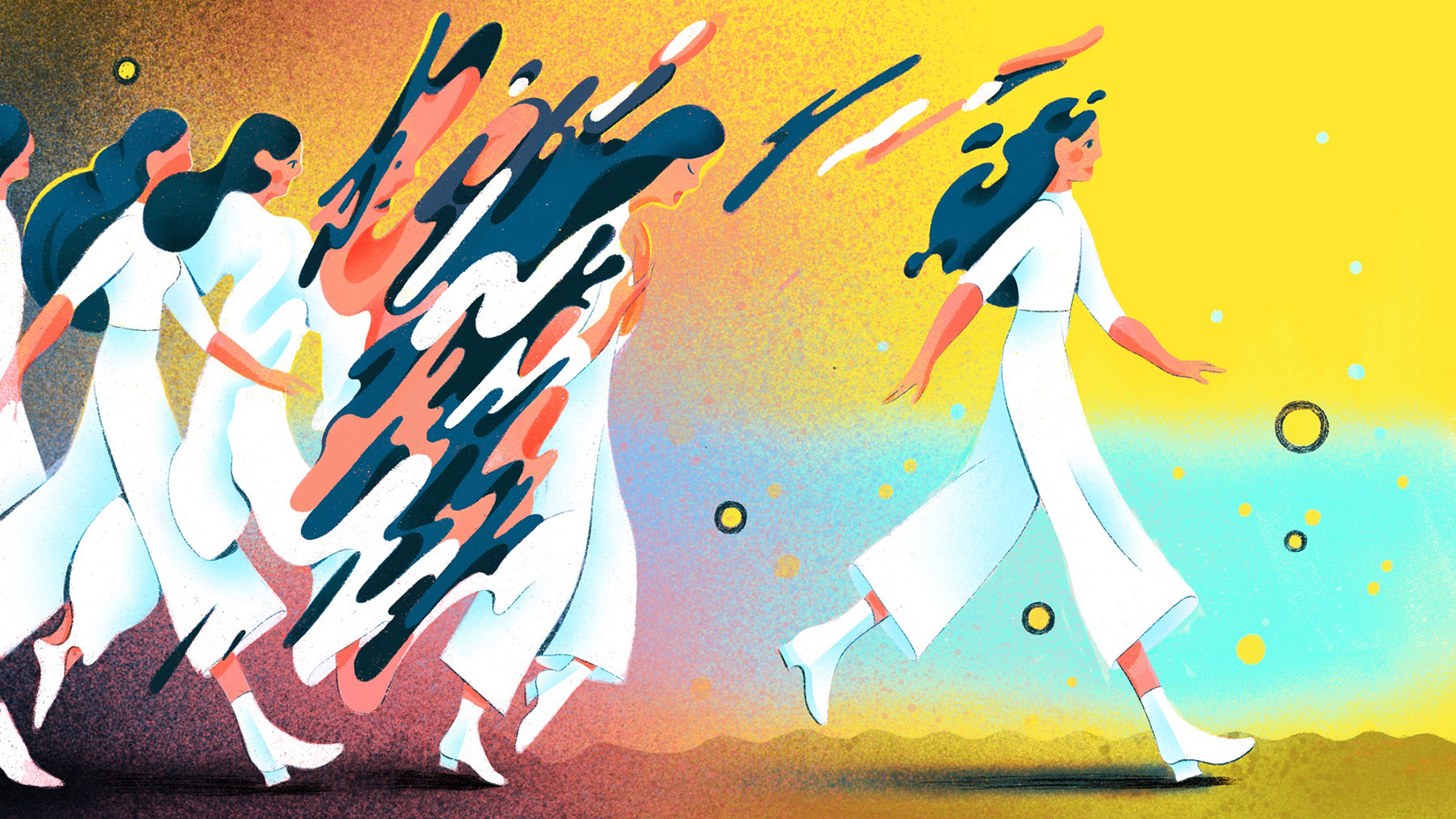A day before her 28th birthday, Dana Donofree was diagnosed with breast cancer. She was in the throes of wedding planning, and, at a time when she should have been meeting with florists and caterers, she was meeting instead with doctors.
由于done in eight womenwill develop invasive breast cancer in her lifetime—and most are between 55 and 64 when diagnosed. Much of the care, support, and products are designed for this demographic in a way that includes matronly medical bras and community conversations that don’t address sexuality, dating, and fertility. But what about women like Dana, who find themselves as 20-somethings on the other side of cancer? The world isn’t ready for survivors like them.
After her bilateral mastectomy, Dana, like many younger survivors, elected to have reconstructive surgery. Her body in the aftermath of cancer had completely changed, she says. Dana, who was working in fashion at the time, dumped a drawer of fancy, sexy bras in the trash, and she altered much of her work wardrobe to accommodate a sports bra. “That was just damaging on levels that I didn’t necessarily expect,” she says.

Through her own experiences, she identified a glaring hole in the market: sexy intimates for breast cancer survivors. “Cancer took away my breasts, but it wasn’t going to take away my feeling sexy or good about myself,” she says. With few options on the market, she decided to create her own. In the spring of 2014, she launched online intimates brandAnaOno.
While building the brand, however, she was also continuing treatment and working a full-time job, with李ttle money in her bank account.It took her seven months longer to launch than she had expected.
AnaOno
The brand’s mission started as a practical one—solving a problem with a product—yet it soon became intertwined with the emotional needs of its customers and the community. A bra’s purpose is to hold breasts in place, but, Dana says, it means so much more to a woman’s identity. It was a connection she didn’t make until it was taken away from her.
Since then, Dana has been connected to a network of young women—her customers and fellow survivors—who have echoed her own struggles with her identity as a woman. “You’re used to dolling yourself up, but your hair is missing, your eyelashes are missing, your eyebrows are missing, and now you don’t have any breasts,” she says. ”Your slate is wiped clean.” But she learned that the challenges were much more nuanced than she expected.
Before launch, Dana had a customer like herself in mind: women with reconstructive surgery, with two breasts. But feedback from the community helped grow the brand’s collection and customer base. She heard from women with one breast, with no breasts, women using forms or prosthetics, and those not.
Just because you don’t need [a bra] doesn’t mean you don’t want it.
Dana Donofree, founder of AnaOno
At the time, there was little on the traditional market to meet all of their needs. One customer told her she couldn’t wait for the day her husband could “unhook a black bra again.” In response to the comments, in 2017, AnaOno launched a Flat and Fabulous bra designed for women with no breasts. “Just because you don’t need [a bra] doesn’t mean you don’t want it,” Dana says.
虽然她说,每个女人都值得去感受sexy, the issues faced by younger women tend to go even deeper—self-confidence, body image, intimacy, sexuality, fertility. “If you’re talking to somebody [in the community], either nipples or sex come up within the first 10 minutes. It’s just our rule of thumb,” she says.
The conversations at the community level are changing for the good, but breast cancer awareness at large is still problematic. On the subject of “pink washing,” Cynthia Bestman, founder of Violets Are Blue skincare,toldAllure, “The problem is that a lot of people don’t connect the dots that ‘awareness’ does not mean ‘find a cure.’ Companies don’t need to give a penny to a charity if their objective is only awareness.”
Dana launched her business to an under-serviced community and became a trailblazer in the space…
Breast cancer is a disease that’s been commercialized and marketed more than any other. We’re aware of it, Dana says, but the death rates have remained steady for 20 years. “It’s easier to fling around a pink feather boa than it is to talk about the bodies you just put in the ground,” she says.
Though Dana’s in the business of selling bras, her success has nothing to do with bras, she says. She measures her impact through the women she’s been able to help and inspire through her own story. And she’s conscious to give back in ways that are transparent and directly impact the women in the community. She serves as a co-chair of Jill’s Wish and a board member of Living Beyond Breast Cancer. In its partnership with Pink Warrior Angels, AnaOno also offers free bras to women requiring financial assistance.
Danalaunched her businessto an underserved community and became a trailblazer in the space, but she has since seen a shift as more options hit the market.索菲娅玫瑰密友is another brand in the bra business, launched by a team of sisters in response to their own mother’s post-op struggles. AndCare+Wearis selling fashionable PICC (peripherally inserted central catheter) armbands for people undergoing chemotherapy treatments.
Just Nips
Many businesses have been conceived as a way to service the breast cancer community, though some have found a surprising secondary clientele in young survivors. Such was the case with Molly Borman, who started out trying to solve a fashion problem. Molly liked the look of a natural nipple under a shirt, so she aimed to re-create it in a pastie. The 26-year-old experimented with different materials like erasers and halved Mardi Gras beads before approaching a manufacturer.
Molly’s company,Just Nips, aims their marketing squarely at young women with cheeky taglines like “Boners for her” and “Look cold, feel hot” and content pushing at the edges of social media policies. “For a while, a lot of our stuff was being flagged,” Molly says.

For her launch, she wanted to attach her brand to the breast cancer cause but faced challenges: nonprofits didn’t want to work with her without a hefty monetary donation. Few new businesses like Molly’s break even in their early days. She found a lack of transparency in the breast cancer donation model as well, and Think Before You Pinkwarnsthat many breast cancer initiatives overstate impact.
What Molly realized, though, is that she was already inadvertently reaching a somewhat hidden subset of the breast cancer community. Women with reconstructive surgery were buying her product as an alternative to reconstructed nipples or the medical prosthetics on the market. That’s when she changed her plan. Rather than donating money, she would donate product. Just Nips works on a one-for-one giving model—providing a pair to a survivor, chemo center, or support group for every pair purchased. She’s never turned down a woman who has reached out directly.
It’s just funny when you’re like, ‘I swear this is going to work,’ and no one believes you.
Molly Borman, founder of Just Nips
Her work with the breast cancer community, though, caused her to doubt her marketing. “Our branding is very sexually charged. It’s very tongue-in-cheek, not your typical breast cancer messaging,” she says. But the community has urged her to stay the course, hers being a refreshing change from the safe pink messaging. “With breast cancer, there’s such an emphasis on women feeling like they’re losing their sexuality,” Molly says.
Following her launch in 2016, a flood of press followed. The brand has become wrapped up in the women’s movement, with many customers having worn her product to protest President Donald Trump, she says. Suddenly, the breast cancer organizations were calling her back. “It’s just funny when you’re like, ‘I swear this is going to work,’ and no one believes you,” she says.
Molly has worked with theKeep a Breast Foundation, as its target aligns with her core customer. “They believed in us from the start,” she says. “It’s because they are in tune with the younger audience.” The organization provides breast health education to young women globally, and Molly has worked with them to produce self-examination instructions that ship with packages of Just Nips. “Early detection is obviously the most important message we could ever get across,” she says.
Studio Sashiko
Several years ago, Shaughnessy Keely, along with her partner, openedStudio Sashiko, a cosmetic tattoo shop in Langley, British Columbia. She began microblading eyebrows before the trend exploded, becoming an early influencer in the industry. The growing studio has since hired several artists, but it still books every appointment in the calendar months in advance.
After her aunt underwent a preventative mastectomy with reconstruction and her reconstructed nipples fell off, Shaughnessy began to investigate the options for women post-op. “Everything I’ve seen is just a bingo dabber dot like a plastic surgeon will give you,” she says. She started to research, and experiment with sketching, before adding nipple tattooing to her repertoire.

Shaughnessy’s work in tattooing freckles and eyebrows laid a foundation for color-matching and working on sensitive areas of the body. But tattooing breasts, especially with scar tissue, posed additional challenges. “I’ve worked with a lot of scar tissue, but it’s so different on very stretched out areas. You could do more damage with tattooing if you don’t know how to work the skin.” It’s also a more intimate and vulnerable experience for clients than any of her other services.
Shaughnessy has worked with cancer survivors before, though. Microblading has become a popular option for women who lose their eyebrows to chemotherapy, and many of her past clients are now returning for nipple tattoos. The service, while on the surface a cosmetic one, has brought emotional healing for many of Shaughnessy’s clients. A common sentiment from survivors, she hears, is that, looking in the mirror, they focus on the scars and are reminded of the cancer. “As soon as they have that nipple on there, it kind of distracts from everything,” she says. “They look in the mirror and feel normal again.”
Shaughnessy says she hopes to explore alternatives to tattooing realistic nipples, as many women post-surgery are choosing art or personal tattoos, some covering the entire reconstructed breast or scar tissue.
When Dana was discussing reconstruction with her surgeon, she learned that she would be losing her nipples. She opted not to have them reconstructed too. As a fan of tattoos already, she approached an artist to create something more personal than a tattooed nipple. She chose a cherry blossom tree for its symbolism. “It was the moment of time when I took back my life. I took back making decisions for myself. My doctors weren’t making them for me anymore,” she says.
In 2017, in the U.S. alone, more than12,000 reported casesof breast cancer affected women under 40, leading to nearly 1,000 deaths. The numbers spike sharply after 40, and over 14,000 more U.S. women will be diagnosed by 45. But while women under 40 are a smaller demographic relative to those most impacted by breast cancer, the group not only requires early detection but also has other unique needs.
Brands like Just Nips and AnaOno, as well as influencers like Shaughnessy, are bringing a new kind of awareness and support to young women. It’s not a pink ribbon—it’s frank conversation, education, and actual solutions to help young survivors regain a sense of wholeness in the aftermath of cancer. “You’re a woman,” says Dana, “and cancer can’t cut that away.”
Illustrations by Rebekka Dunlap

